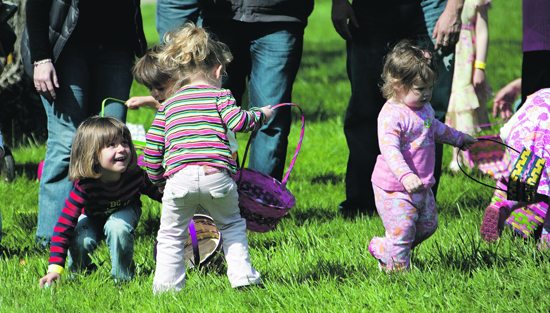
| ||||||
This method that I found online at Aki's Kitchen, uses pantyhose to secure the design material to the hardboiled egg. It takes a little bit of practice to get it just right, but once you get the hang of it, it is really fun.
You can use old pantyhose-if they are clean, but I just went to the store and bought a box of cheap knee highs to use for my egg wraps. Cut the nylons into squares, large enough to wrap around the egg with enough spare to cinch closed with a twisty tie, about 5 inches square.
Using a little water to moisten the leaves or the paper dots, place the leaf (or dots) on the hardboiled egg. Dry off excess water with a dry towel. Lay the egg on top of the nylon square, with the design material face-down onto the nylon. At this point you can lay another leaf on top of the egg, using a little water to make it stick. Then gently pull the nylon around the egg, being careful to hold the bottom design piece in place, while gathering all four corners of the nylon into a bunch to be secured with a twisty tie, not moving the top design out of place.
As I mentioned, this takes a little practice, but you will master it quickly.
Then, place wrapped egg in dye cup and allow to sit for 5 to 10 minutes or so, depending upon how vibrant or pastel you want your eggs. The darker the color, the better the pattern will stand out. Remove egg from dye and allow to sit for 5 to 10 minutes. Then remove nylon wrapper, blot egg with a paper towel to dry it, and remove the weed (or other design material!)
To make the star pattern with rubber bands, just wrap egg with several rubber bands and dip in dye bath. You really don't need to wrap the eggs in the nylons for this effect.
I used PAAS dyes, but you can make natural dyes out of fruits and veggies, or simply make your own colors with your basic red/blue/yellow/green food coloring kit. I used the "ultra-vibrant" color method on the back of the PAAS box to make sure I'd get a good contrast between the colored egg and the pattern. This seemed to work very well, except for the orange and yellow, which were more muted tones.
For natural food dyes, you can use a wide variety of produce and spices including: beets, turmeric or saffron, chili powder, red, blue or purple fruit juices, blue, black or raspberries, shredded carrots, spinach or red cabbage, and tea will give you a light brown or tan color. Red wine works too, but I'm not sure it's the best use of a good bottle! My egg dipped in Cabernet Franc turned out a very light purple.
In order to elicit color from some of these foods, they must first be boiled, and boiling the egg with the food and vinegar will give the boldest color. Other you don't need to boil, but I have found they result in more pastel hues. I have not tried all of these, just a few, and they turned out lighter in color. The food coloring eggs turned out just like the Easter egg dyes and you can determine the boldness of the color by adding more or less drops of food coloring to the water.
Have fun with the patterns. If you have hole punches that cut out different shapes, you can apply those in place of the round hole punch dots.
Happy Easter!
For more information on natural food dyes, please visit: http://chemistry.about.com/od/holidayhowtos/a/eastereggdyes.htm


Reach the reporter at:
Copyright
